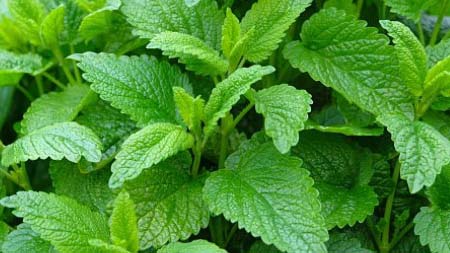How to Grow Lemon Balm in Your Garden

Lemon balm (Melissa officinalis), also called heart’s delight, lemon mint, balm mint, blue balm, garden balm, or sweet balm, is a useful perennial herb for the garden. Lemon balm has heart-shaped or slightly rounded leaves, square stems, and has a strong lemon aroma and flavor. Plant 18 inches apart in the early spring in an enriched soil. Water regularly, but fertilize sparingly, throughout the year. Regular harvest will help contain its growth. Use lemon balm fresh, or dry for storage. Lemon balm propagates easily, is a lowmaintenance plant, and will make a nice addition to your home garden.
Lemon Balm Varieties
Common varieties include “Aurea” (leaves are light green with blotches of gold) and “All Gold” (completely golden leaves). There are other species of lemon balm like plants from the Mediterranean and Asian regions, but only Melissa officinalis L. is cultivated. Check for seed or plant availability with your local garden center or from various seed catalogs.
How to Grow Lemon Balm
Soils
Lemon balm grows in most soil types provided it is rich, humus filled, moist, and well-drained.
Plants
Lemon balm is propagated from seeds or transplants grown from stem and root cuttings (divisions) or by layering. To grow lemon balm from seeds, sow in the early spring (around March). Since the seeds are very small, cover them with a fine layer of soil and keep the area moist. A more reliable method to propagate lemon balm is by layering. Select a 6 to 12 inch long, low-growing flexible stem and make a small cut on the underside of the stem. Stake the stem to the ground and cover it with 2-3 inches of soil. Roots will grow from the stem near the cut in 1 to 2 months. Plant division is the easiest ways to propagate lemon balm. Root pieces, containing three or four buds, are dug up from established plants and these are used to start new plants. Divisions are made in late August or September so new growth can occur before the first frost. Mulch new plants heavily to improve winter survival.
Planting and Spacing
Lemon balm grows from 2 to 3 feet high and should be spaced 18 to 24 inches apart. Lemon balm prefers full sunlight but will tolerate light shade. Plants grown with some shade tend to produce larger and more succulent leaves.
Water
Lemon balm is a hardy perennial herb that grows best when it is not water stressed. Keep the soil moist, but not wet, or the plants will get root rot. Supply water through drip or overhead irrigation and mulch around the plants to conserve soil water.
Fertilizer
Lemon balm responds to general all purpose fertilizer. Feed in the spring to encourage new growth and again after harvest to encourage additional leaf growth. Over-fertilization causes excessive growth and poor flavor development.
Mulching
Mulching helps conserve soil moisture, control weeds, and aids in plant survival over the winter. Organic mulches include grass clippings, bark, leaves, compost, or shredded newspapers.
Problems with Growing Lemon Balm
Weeds
Weed control is very important because the presence of weeds in the dried product will reduce the quality of the herb. Lemon balm, like mint spreads rapidly (becomes weedy) and can take over an herb bed. Growing plants in containers helps control this problem. If planted in the soil, harvest the leaves regularly, remove the flowers before they set seed, and dig around the plant edges to reduce root spreading.
Insects and Diseases
Lemon balm is generally not bothered by insects or diseases because of its high natural oils concentration. Powdery mildew and root rots can be a problem if plants are over-watered. There have been reports of aphid and mite problems affecting plant growth.
How to Harvest and Cure Lemon Balm
Frequent harvest encourages branching and will keeps lemon balm bushy and compact. Harvest about one-third of the foliage at monthly intervals to encourage healthy growth. Harvest before the plant starts to bloom, being careful not to bruise the leaves. After harvesting, tie the stems in a bundle and hang them indoors out of direct sunlight or in a shady place to dry. Dried leaves retain their green color, but are not as fragrant as when used fresh. Carefully strip the dried leaves from the stems and store in airtight containers.
Lemon Balm Plant Productivity
Production depends on the variety planted and number of plants grown. Plant two to three plants for fresh use and an additional two to three plants for storage.
Lemon Balm Uses and Nutrition Facts
Lemon balm has a variety of culinary, medicinal, and ornamental purposes. Fresh sprigs are used to flavor drinks and as garnishes in salads and main dishes. Dried leaves can be used for teas, soup flavorings, and for medicinal purposes. The oil of lemon balm is also used to make perfumes.
Many herbs are used for their claimed health benefits. For more information on herbal medicines, refer to a reliable information source for details on the benefits or hazards to using an herbal medicine. One such source is the National Institutes of Health’s herbal medicine Web site: http://www.nlm.nih.gov/medlineplus/herbalmedicine.html
Published May 2020
Utah State University Extension
Peer-reviewed fact sheet
Download PDF
Authors
Hyrum Gillespie and Dan Drost, Vegetable Specialist
Related Research







